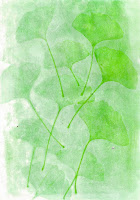Pressure printing, or stratography, uses a flexible plate and type-high surfaces. The image is transferred with variating amounts of pressure to the sheet of paper. The resulting image shows a combination of ink density based on the amount of pressure applied to each area. The printed image is not as clear and sharp as ones made by direct impressions.
 |
| horsetail stained paper |
The process is an easy and quick way to make an image that is not reversed. It can also be used to create textures and patterns from paper, fabric, leaves or other thin objects. I experimented with paper stacks as well as different leaves.
For my first print I used a combination of stacked paper, dried
false papyrus leaves and fresh
horsetail stalks. There was a significant difference in thickness between these objects and as a result some of the print received too much ink and other parts too little ink. The horsetails, since they was green and not dry, stained the paper green. The image at the right shows both the stalks and cut stalks that show up as circles.
The second print I did using dried ginko leaves and I was able to make a reversed second print.



No comments:
Post a Comment